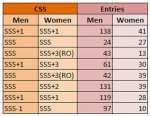Imurg
The Grinder Of Pars (Semi Crocked)
If everybody played 'rubbish', there must have been something difficult about the course that day, such as hard fast running greens or awkward pin positions, even if the weather was benign. We had one qualifier at our club that was like that earlier this summer. Provided you had a large enough field it is statistically unlikely that they all played badly in easy weather conditions, hence the CSS would be expected to go up.
CSS assumes that everyone is playing the same, relative to their handicap. If everyone played badly it is assumed that the course set up is tricky or the weather bad. Likewise if everyone plays well it is assumed to be good weather and/or an easy set up.
On any given day, any of us can play well, mediocre or badly - regardless of the weather, set up or how anyone else is playing.
My handicap is an indication of my ability to play against the course. It's only relative to anyone else if we all play to our handicaps - but we have good days, bad days and mediocre days.
Our initial handicaps have no relation to how anyone else plays. It is based on a fixed number, SSS. It could be a rank, rotton day with high winds but if that's the day you put your best of 3 cards in then that's the card that determines your handicap. Everyone else might NR or shoot a cricket score but that doesn't affect you.
If you put a Supplementary card in, SSS is used. If everyone playing a Comp didn't enter the Comp but entered a Supplementary then SSS would be used for each one.
If the 2 Guys I'm playing with enter the Comp but I put a Supplementary in, their handicap gets adjusted on the comp CSS and mine uses SSS and yet we've played at the same time, under the same conditions on the same course.......
If that doesn't make it a farce then there's no hope...

